Welcome to the creme de la creme, the number one through ten prospects. In case you missed it number 11 through 20 are here, and number 21 to 30 are here.
We hope you enjoyed this top 30 and the hope it brings to the future of the Blue Jays organization.
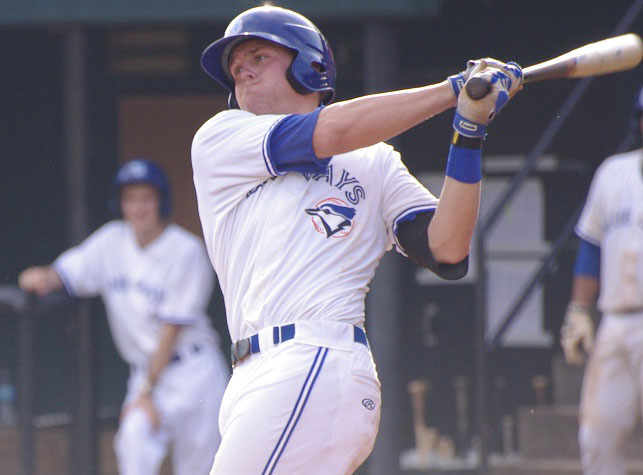
Image from BlueJaysFromAway.com.
10. Mitch Nay | 3B
| Year | Age | Level | AB | 2B | 3B | HR | BB | K | SB | CS | AVG | OBP | SLG |
| 2013 |
19 |
RK+ |
230 |
11 |
0 |
6 |
25 |
35 |
0 |
1 |
.300 |
.364 |
.426 |
| 2014 |
20 |
A |
473 |
34 |
3 |
3 |
39 |
79 |
6 |
2 |
.285 |
.342 |
.389 |
| 2014 |
20 |
A+ |
37 |
1 |
0 |
0 |
3 |
9 |
0 |
1 |
.189 |
.250 |
.216 |
Mitch Nay was selected by the Jays 58th overall in the supplemental round of the 2012 draft out of high school in Arizona. Mitch signed for $1,000,000, slightly over slot to draw him away from his commitment to Arizona State University.
Mitch's first taste of affiliated ball was in 2013, as he hit a solid .300/.364/.426 over 258 PA with Bluefield with a respectable walk and strikeout rate. In 2014 Mitch started the season with Lansing batting .285/.342/.389 over 558 PA, with a late season promotion to Dunedin. In his short stint with Dunedin Mitch struggled to .189/.250/.216 over 40 PA.
Expect Mitch to start 2015 in Dunedin, as he continues to develop as a power corner infielder in his age 21 season.
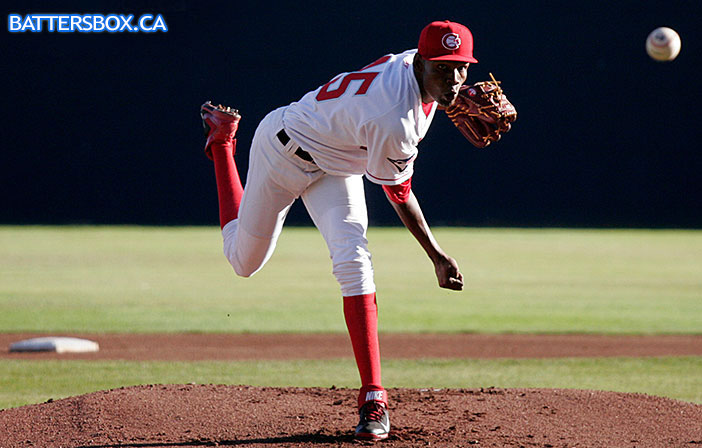
| Year | Age | Level | G | GS | IP | H/9 | HR/9 | BB/9 | K/9 | ERA |
| 2013 | 18 | RK- | 11 |
10 |
53.0 |
6.8 |
0.00 |
2.0 |
12.1 |
1.36 |
| 2013 | 18 | RK | 3 | 2 | 15.0 |
6.6 |
0.0 |
1.2 |
8.4 |
2.40 |
| 2013 | 18 | RK+ | 1 | 0 | 2.0 | 4.5 | 0.0 | 0.0 | 13.5 | 0.00 |
| 2014 | 19 | A- | 10 | 10 | 50.1 | 6.4 | 0.4 | 3.6 | 9.5 | 2.15 |
| 2014 | 19 | A | 4 | 4 | 21.2 | 4.2 | 0.8 | 2.9 | 8.3 | 3.74 |
| 2014 | 19 | A+ | 2 | 1 | 8.2 | 4.2 | 2.1 | 3.1 | 5.2 | 3.12 |
Miguel Castro burst on the scene last summer with a strong showing in the GCL. This year he was assigned to Vancouver where he made ten starts and delivered a 2.15 ERA. However in one start he allowed six runs, half of the runs he allowed in Vancouver. Outside of that start his ERA was just over 1.00. That earned Castro a promotion to Lansing where he pitched well in four starts and then on to Dunedin where he made two starts. Dunedin was the best challenge for Castro, he allowed a home run in each of his starts and his strikeout rate dropped. Castro will likely start 2015 in Dunedin.
Castro is 19 and won't turn 20 until Christmas Eve. His success comes from his tall lanky frame, he is listed at 6'5", a low 3/4 sling shot-type delivery and a mid-90s fastball that he can command low in the zone. Castro also features a breaking ball and a change, both of which need work. Castro's poorer results in Dunedin show that he needs those secondary pitches to get better before he can continue the move up. Those pitches are also necessary to slot his future as a starter rather than as a reliever.
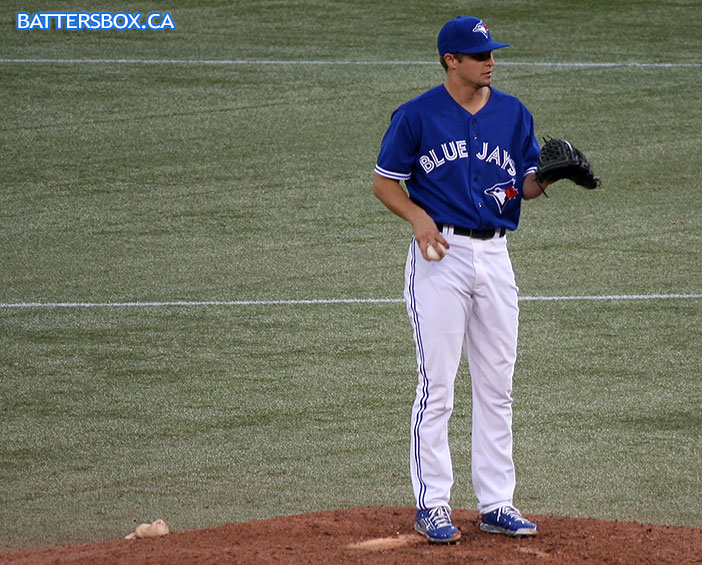
8. Kendall Graveman | RHP
| Year | Age | Level | G | GS | IP | H/9 | HR/9 | BB/9 | K/9 | ERA |
| 2013 | 22 | A | 10 | 10 | 39.2 |
9.3 |
0.7 |
2.9 |
5.7 |
4.31 |
| 2014 | 23 | A | 4 | 4 | 26.1 | 3.8 | 0.0 | 2.1 | 8.5 | 0.34 |
| 2014 | 23 | A+ | 16 | 16 | 96.2 | 8.3 | 0.1 | 1.7 | 6.0 | 2.23 |
| 2014 | 23 | AA | 1 | 1 | 6.0 | 12.0 | 0.0 | 3.0 | 6.0 | 1.50 |
| 2014 | 23 | AAA | 6 | 6 | 38.1 | 8.9 | 0.2 | 1.2 | 5.2 | 1.88 |
| 2014 | 23 | MLB | 5 |
0 |
4.2 |
7.7 |
0.0 |
0.0 |
7.7 |
3.86 |
The Blue Jays acquired Kendall Graveman via the 2013 draft in the 8th round after he spent four years at Mississippi State University. Kendall signed for $5,000, which was roughly $100,000 under slot for his draft position.
Kendall briefly played for Lansing in 2013 after he signed, putting up fairly mediocre numbers in 10 starts. Kendall started 2014 in Lansing again, with brief stops in Dunedin, New Hampshire, Buffalo, and finally Toronto in September.
Kendallís 2014 minor league season was a giant surprise for the Jays, as he pitched 167.1 innings over 4 levels, finishing with a 1.83 ERA. He finished second in the minors in 2014 ERA, just slightly behind Pirates prospect Tyler Glasnow who finished with an ERA of 1.74. Kendall credits his success in 2014 due to the cutter he added by mistake during a start in Dunedin. Despite the strong 2014 campaign, he will probably start 2015 in Buffalo knowing that he is only a phone call away from Toronto.
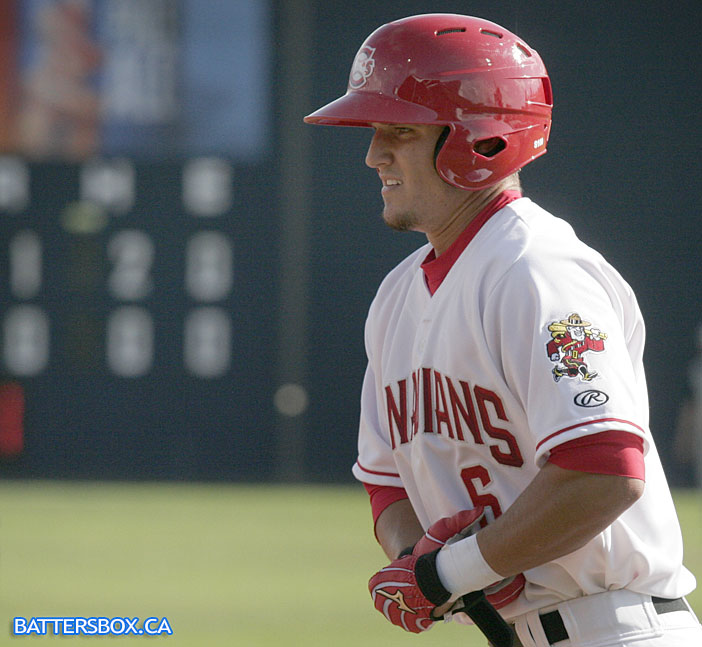
7. Max Pentecost | C
| Year | Age | Level | AB | 2B | 3B | HR | BB | K | SB | CS | AVG | OBP | SLG |
| 2014 |
21 |
RK |
22 |
2 |
0 |
0 |
0 |
3 |
0 |
1 |
.364 |
.364 |
.455 |
| 2014 |
21 |
A- |
83 |
2 |
3 |
0 |
2 |
18 |
2 |
1 |
.313 |
.322 |
.410 |
Max Pentecost has been busy maxing out the room in his trophy case after piling up the awards over the last couple of seasons. The Winder, Georgia native was named the Most Valuable Player of the Cape Cod League in 2013 after a batting line of .346/.425/.538 along with six home runs and 29 runs batted in with the Bourne Braves. His performance on the Cape also earned him College Summer Player of the Year honours from Perfect Game. He earned more hardware this season by capturing Atlantic Sun Conference Player of the Year honours and the Johnny Bench Award as the top catcher in the NCAA. He was also named a finalist for the Dick Howser Award as college baseballís top player. That was after batting .422 and putting up an on-base-plus-slugging mark of 1.109 in his junior season with Kennesaw State, the same college Chad Jenkins attended. He racked up 24 doubles, two triples and nine home runs to go along with 61 runs batted in. Even more impressively, Pentecost stole 17 bases last year and was 25-for-25 in his three-year college career. The 6-foot-2 catcher helped the Owls reach the Super Regional but they wound up losing to Louisville, who advanced to the College World Series in Omaha.
Pentecost was selected 11th overall in the 2014 draft, a pick the Jays received after their inability to sign 2013 first-round pick Phil Bickford. Jim Callis of MLB.com rated Pentecost as the best pure catcher in the draft. Agreeing to a slot bonus of $2.9 million, he made his pro debut in the Gulf Coast League July 7. He was to report to Vancouver initially but he did not have a passport. In just his second game in the GCL, the right-handed hitter went 5-for-5 with two doubles and two RBI. He finally made it into Canada for his Cís debut July 15. His first at-bat resulted in a sacrifice fly and he went on to go 2-for-3 with a double and a run scored in a win over Eugene. He began his Vancouver career with a nine-game hitting streak and had a six-game streak that carried into early August. However, he missed the rest of the season with a wrist injury and just underwent surgery for a partially-torn labrum in his shoulder earlier this month according to Alexis Brudnicki of CanadianBaseballNetwork.com. Recovery time is estimated at four months. Itís not the first time Pentecost has been sidelined. He suffered an arm injury during his senior year in high school but he was still taken by the Texas Rangers in the 7th round of the 2011 draft.
Jays roving catching instructor Sal Fasano called Pentecost ultra-athletic and said he was working with him on his set-up behind the plate, which he described as slightly awkward. Fasano also told Sportsnet Radio The Fan 590 he agrees with the Jason Kendall comparison to Pentecost but says the young catcher is faster than Kendall and Buster Posey. He believes Pentecost has the ability to create his own niche in the bigs. He also believes young catchers do not mature until theyíre about 27 years old as they have to defend, handle a pitching staff and hit - pointing to Yadier Molina as a prime example.
Pentecost, who will turn 21 on March 10, should find his way to Lansing in 2015. Itís hoped he will be ready to catch more games after donning the tools of ignorance just 10 times in both the Gulf Coast and Vancouver last season. He was rated the number eight prospect in the Northwest League by Baseball America.
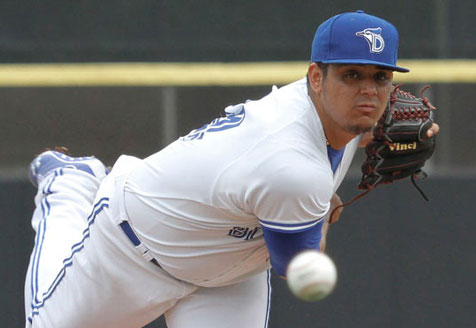
Image from MiLB.com.
6. Roberto Osuna | RHP
| Year | Age | Level | G | GS | IP | H/9 | HR/9 | BB/9 | K/9 | ERA |
| 2012 |
17 |
RK+ |
7 |
4 |
24.0 |
6.6 |
0.4 |
2.2 |
9.0 |
1.50 |
| 2012 |
17 |
A- |
5 |
5 |
19.2 |
6.8 |
0.5 |
4.1 |
11.4 |
3.20 |
| 2013 |
18 |
A |
10 |
10 |
42.1 |
8.3 |
1.4 |
2.3 |
10.8 |
5.53 |
| 2014 |
19 |
RK |
1 |
1 |
1.0 |
0.0 |
0.0 |
0.0 |
18.0 |
0.00 |
| 2014 |
19 |
A+ |
7 |
7 |
22.0 |
11.5 |
1.2 |
3.7 |
12.3 |
6.55 |
2014 was basically a write-off for Roberto Osuna. Yes it's good that he returned from Tommy John surgery to pitch but the results were inconsistent. There is a lot of attention paid to a pitcher returning after surgery, usually at the one year anniversary. But it is usually the second year after surgery when you see thr real post surgery pitcher. since his rteurn Osuna has shown good fastball velocity but poor command. This is normal. He struck out over 12 hitters per inning for Dunedin which is excellent but he also gave up over 11 hits per nine innings which is not good.
In 2015 Osuna should be back to full strength, ready to go. He will likely return to Dunedin which is just fine for a twenty year old. Osuna is currently pitching in the AFL with the same mixed results. The innings will give him a good base to start 20145 in a comfortable position.
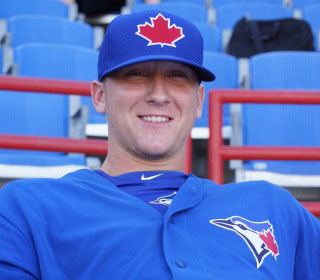
Image from Eddie Michels.
5. Jeff Hoffman | RHP
| Year | Age | Level | G | GS | IP | H/9 | HR/9 | BB/9 | K/9 | ERA |
| 2012 |
19 |
NCAA |
19 |
10 |
73.2 |
7.3 |
0.5 |
2.6 |
6.7 |
3.67 |
| 2013 |
20 |
NCAA |
15 |
15 |
109.2 |
8.1 |
0.3 |
3.2 |
6.9 |
3.20 |
| 2014 |
21 |
NCAA |
10 |
10 |
67.1 |
7.1 |
0.5 |
2.7 |
9.6 |
2.94 |
Jeff Hoffman has yet to throw a pitch in a Jaysí uniform so I will limit my waxing of his talents. Widely tipped to be one of the top players taken in this past yearís draft, Hoffman fell to the Jays at nine due to elbow issues. Hoffman has undergone Tommy John and should be pitching for a Jaysí affiliate sometime next year.
If he regains his college repertoire, the Jays will have a serious prospect on their hands. Hoffman throws his fastball in the mid-90s throughout his starts with solid command. He possesses a 12-6 curveball, slider and changeup. His delivery is a tad wonky, but repeatable, and he has the frame to suggest he can handle some innings. Hoffman has been compared to a poor manís Adam Wainwright. Provided he comes back healthy, Hoffman could move quickly through the organization.
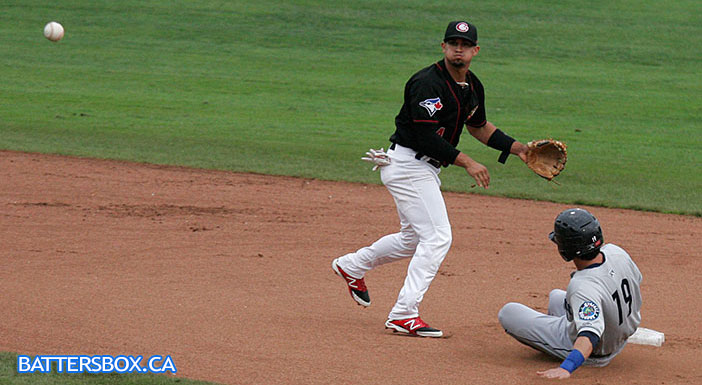
| Year | Age | Level | AB | 2B | 3B | HR | BB | K | SB | CS | AVG | OBP | SLG |
| 2013 |
17 |
RK |
174 |
16 |
6 |
4 |
13 |
42 |
10 |
4 |
.299 |
.368 |
.529 |
| 2013 |
17 |
RK+ |
54 |
5 |
1 |
0 |
2 |
14 |
0 | 2 | .204 |
.259 |
.333 |
| 2014 |
18 |
A- |
289 |
23 |
4 |
6 |
26 |
64 |
29 |
5 |
.311 |
.384 |
.481 |
Why was Franklin Barreto the number one prospect in the Northwest League according to Baseball America? Letís begin at the beginning. The Caracas, Venezuela native went 4-for-4 with a walk and a run batted in on Opening Night to spearhead Vancouverís 11-2 victory in Salem-Keizer June 13. That was one of four four-hit performances on the season and it highlighted a five-game hitting streak in which he batted .571 to start the year. After a .333 batting average in June, the right-handed hitter slipped to .287 in July but still managed to string together a 10-game hitting streak. He earned a berth in the Northwest League All-Star Game and went on to lead the Canadians back to the postseason with a .324 batting average that included four of his six homers in August. As the number three hitter, he teamed up with Roemon Fields and Tim Locastro to form a speedy trio at the top of the Vancouver order that stole a combined 109 bases, led by Fieldsí 48. Barreto also had a hit in all four of Vancouverís playoff games, going 5-for-18.
As great a season as he had with the bat, the 5-foot-9 shortstop did not have a great season with the glove as he committed 26 errors for a .913 fielding percentage. His throws to first base were not very accurate at times and was saved a handful of errors by first baseman Ryan McBroom and his scooping ability. That fueled prior speculation that Barreto will be moved off of short to either center field or second base.
Signed as a free agent out of Venezuela in 2012 for $1,450,000, Baseball America says Barreto has shown quick hands, good plate discipline and a line-drive stroke with the ability to drive the ball to right field. He projects to have an above-average bat that should lead to double-digit home run totals and plenty of doubles.
The winner of the R. Howard Webster Award as the top minor league performer in Vancouver, Barreto should get his first taste of full season ball with Lansing in 2015. Heíll be just 19 years old on February 27.
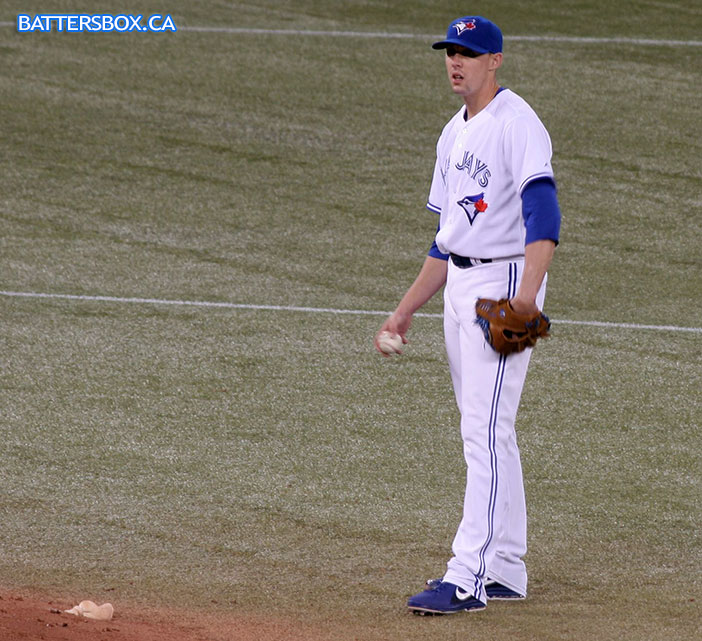
3. Aaron Sanchez | RHP
| Year | Age | Level | G | GS | IP | H/9 | HR/9 | BB/9 | K/9 | ERA |
| 2010 |
17 |
RK |
8 | 8 | 19.0 | 9.0 | 0.5 | 5.7 | 13.3 |
1.42 |
| 2010 | 17 | A- |
2 | 2 | 6.0 | 6.0 | 0.0 | 7.5 | 13.5 | 4.50 |
| 2011 | 18 | RK+ | 11 | 6 | 42.2 | 9.6 | 0.9 | 3.8 | 9.1 | 5.48 |
| 2011 | 18 | A- | 3 | 3 | 11.2 | 6.2 | 0.0 | 6.2 | 10.0 | 4.63 |
| 2012 |
19 |
A |
25 |
18 | 90.1 |
6.4 | 0.3 | 5.1 | 9.7 | 2.49 |
| 2013 |
20 | A+ |
22 |
20 | 86.1 |
6.6 | 0.4 | 4.2 | 7.8 | 3.34 |
| 2014 |
21 | AA |
14 |
14 |
66.0 |
7.1 |
0.3 |
5.5 |
7.8 |
3.82 |
| 2014 |
21 | AAA |
8 |
6 |
34.1 |
9.4 |
1.0 |
4.5 |
7.1 |
4.19 |
| 2014 |
21 | MLB |
24 |
0 |
33.0 |
3.8 |
0.3 |
2.5 |
7.4 |
1.09 |
While other organizations have seen their front-end pitching prospects race through the minors to much acclaim, only to experience injury or poor performance in the big leagues, the Jays have taken a conservative approach with Aaron Sanchez. It had been station-to-station for Sanchez, building his innings and perpetually tinkering with his delivery. That, however, changed this year. Sanchez pitched at three levels, finishing the year off in the Jays bullpen where he was arguably the best pitcher for the Jays down that back stretch. Sanchez got his innings up to 130+ and showed he can handle major league hitters. In the 100 odd minor league innings he started in New Hampshire and Buffalo, he tallied 84 strikeouts and 57 walks. His ERA came in at 3.95. In 33 innings in Toronto, he struck out 27 and walked nine while allowing just 14 hits. Thatís a 0.7 WHIP to take to the bank. So where and what does he do next year?
Sanchez remains a bit of a tease. Scouts will have worked for 30 years and not see a pitcher as free and easy as Sanchez. He is effortless at 95 mph and briskly walking at 98 mph. His fastball and curveball alone should yield a plus 9.00 K/BB, yet Sanchez still has not approached that number. That, perhaps, is all fine and dandy given the action on his two-seamer, which made the pitch one of the hardest to square up in major league baseball. Nonetheless, the feeling remains that there is so much more Mr. Sanchez has to offer.
Sanchez quite clearly warrants his position on this list. While he has not had the big breakout season Daniel Norris has had, Sanchez still represents (at least in my mind) the organizationís only true fire front end pitching prospect. Heís a starting pitcher and Iíd like to see him pitching in the Jays rotation next April.
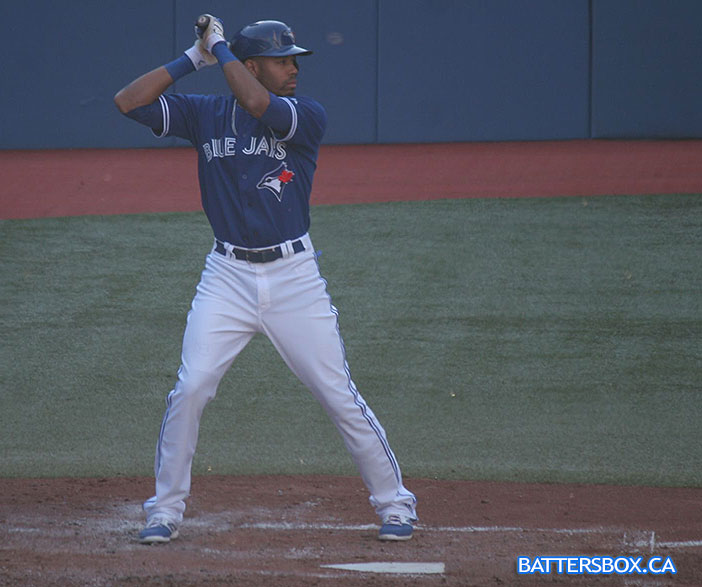
2. Dalton Pompey | OF
| Year | Age | Level | AB | 2B | 3B | HR | BB | K | SB | CS | AVG | OBP | SLG |
| 2010 |
17 |
RK |
47 |
0 |
0 |
2 |
3 |
10 |
4 |
1 |
.191 |
.255 |
.319 |
| 2011 |
18 |
RK+ |
68 |
3 |
0 |
1 |
14 |
23 |
4 |
1 |
.191 |
.353 |
.279 |
| 2011 |
18 |
RK |
158 |
7 |
2 |
4 |
24 |
35 |
19 |
0 |
.259 |
.361 |
.405 |
| 2012 |
19 |
RK+ |
14 |
1 |
1 |
0 |
0 |
2 |
1 |
0 | .357 |
.357 |
.571 |
| 2012 |
19 |
A- |
34 |
3 |
1 |
0 |
9 |
7 |
3 |
0 |
.294 |
.442 |
.441 |
| 2012 |
19 |
A |
22 |
0 |
1 |
0 |
1 |
5 |
1 |
1 |
.227 |
.261 |
.318 |
| 2013 |
20 |
A |
437 |
22 |
9 |
6 |
63 |
106 |
38 |
10 | .261 |
.358 |
.394 |
| 2014 |
21 |
A+ |
276 |
12 |
6 |
6 |
34 |
56 |
29 |
2 | .319 |
.397 |
.471 |
| 2014 |
21 |
AA |
112 |
5 |
3 |
3 |
12 |
18 |
8 |
5 | .295 |
.378 |
.473 |
| 2014 |
21 |
AAA |
53 |
6 |
0 |
0 |
5 |
10 |
6 |
0 | .358 |
.393 |
.453 |
| 2014 |
21 |
MLB |
39 |
1 |
2 |
1 |
4 |
12 |
1 |
0 |
.231 |
.302 |
.436 |
The Blue Jays drafted Dalton Pompey in the 16th round of the 2010 draft out of high school in Mississauga, Ontario. Dalton was drafted as a speedy outfielder with a hitting tool that was a work in progress.
In his 5th professional season with the Jays in 2014, things started to click for Daltonís bat as he hit .317/.392/.469 over 500 PA with 43 stolen bases, across 3 minor league stops in Dunedin, New Hampshire and Buffalo. In September, he was promoted to Toronto and put together a line of 231/302/436 over 43 PA.
Dalton's 2015 future is up in the air, as it seems 50/50 whether he starts with the Blue Jays or Buffalo. Either way, it seems like the Dalton will be patrolling the Jays outfield for many years to come.
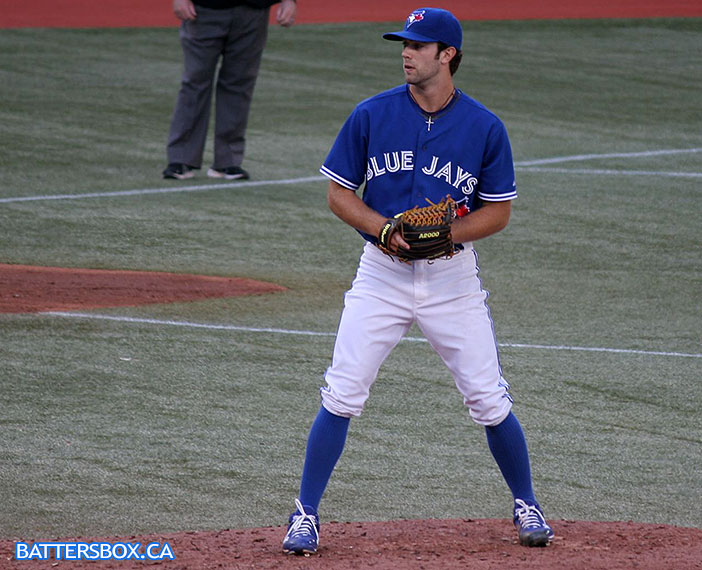
1. Daniel Norris | LHP
| Year | Age | Level | G | GS | IP | H/9 | HR/9 | BB/9 | K/9 | ERA |
| 2012 |
19 |
RK+ |
11 |
10 |
35.0 |
11.3 |
1.0 |
3.3 |
9.8 |
7.97 |
| 2012 |
19 |
A- |
2 |
2 |
7.2 |
16.4 |
0.0 |
5.9 |
5.9 |
10.57 |
| 2013 |
20 |
A |
23 |
22 |
85.2 |
8.8 |
0.6 |
4.6 |
10.4 |
4.20 |
| 2013 |
20 |
A+ |
21 |
1 |
5.0 |
1.8 |
0.0 |
3.6 |
1.8 |
0.00 |
| 2014 |
21 |
A+ |
13 |
13 |
66.1 |
6.8 |
0.0 |
2.4 |
10.3 |
1.22 |
| 2014 |
21 |
AA |
8 |
8 |
35.2 |
8.1 |
1.3 |
4.4 |
12.4 |
4.54 |
| 2014 |
21 |
AAA |
5 |
4 |
22.2 |
5.6 |
0.8 |
3.2 |
15.1 |
3.18 |
| 2014 |
21 |
MLB |
5 |
1 |
6.2 |
6.8 |
1.4 |
6.8 |
5.4 |
5.40 |
Itís not very often that a second round draft pick ranks in the clubís Top 10 prospects the off-season after he was drafted, but Daniel Norris was no ordinary second round selection. Norris fell to the 74th overall pick in the 2011 draft because of concerns over his bonus demands. The Jays signed him for $2 million, which was the fourth highest bonus in club history at that time.
In high school Norris was an elite athlete, excelling in three sports in his first three years. However, he gave up everything else after Grade 11 to focus solely on baseball. Norris posted a 33-3 record at Science Hill High School, which included a no-hitter with 15 strikeouts. The southpaw was named the best high school prospect by Perfect Game Scouting that year. Norris was also named Baseball Americaís High School Pitcher of the Year in 2010 and prior to the draft, Baseball America named him the 16th-best draft-eligible prospect and Keith Law ranked him 33rd.
One reason why teams may have shied away from Norris and his bonus demands was that he was still plagued by an inconsistent delivery in high school, which created issues with his command. Although this is not uncommon among high school pitchers, some high school pitchers never overcome those inconsistencies or are never able to establish a consistent delivery that allows them to maximize their potential.
In his first season as a professional, Norris pitched primarily for Bluefield aside from two starts he made for the Canadians at the end of the season. His problems with his control were evident, as Norris walked 18 batters over 42.2 innings and surrendered 58 hits. He posted an 8.44 ERA on the year, while striking out 43.
After a disappointing 2011, Norris also struggled at the beginning of the 2012 season. As was noted in last yearís minor league review, reportedly a conversation Norris had with Vince Horsman, Lansingís pitching coach, led to a marked improvement. He only threw 90.2 innings in 2013, all but five of them in Lansing. While his ERA was 3.97 on the season, he posted a K rate of 9.9. His walk rate was 4.6 per 9, but his hit rate was only 6.9 from June through the end of the season.
If 2013 hinted at success, 2014 was Norris took a huge step towards realizing his potential. He started the year in Dunedin and had a 1.22 ERA over 13 starts. Norris struck out 76 batters in 66.1 innings and demonstrated control he had never previously shown as a professional by only walking 18. He was promoted to New Hampshire, where he made 8 starts and struck out 49 in 35.2 innings. Norris soon found himself in Buffalo where he struck out 38 in 22.2 innings over four starts and one appearance out of the bullpen. At each of his three stops in the minor leagues, Norris allowed less hits than innings pitched.
Norris was promoted to the major leagues in September and had a memorable major league debut at Fenway Park, striking out David Ortiz. However, his other appearances werenít as impressive and Norris struggled with his control in the big leagues, throwing only 70 of his 138 pitches for strikes.
The 6í2Ē lefty throws four pitches, including a fastball that can reach the mid 90s but usually sits comfortably at about 92-93 miles per hour. His change-up sits in the low-80ís and can be deceptive, particularly against right-handers. Norris also throws a curveball and slider, both of which are still works in progress to some degree. The curveball he struck out Ortiz with demonstrated what one of his good curveballs can look like, as he throws it in the mid-70ís with a hard break. His slider is around 83-85 miles per hour and, like his curveball, has shown a marked improvement over the past couple of seasons. He used his slider as his second-most frequent pitch in the majors, narrowly ahead of his change-up. Itís easy to see Norrisí potential if he can develop consistency with his breaking pitches, as the stuff can look electric at times.
Given his rapid ascension through the minor leagues this year, there were several articles published on Norris and his laid-back attitude, including focusing on the 1978 Volkswagon microbus he bought with his signing bonus and his recently-discovered love of surfing. Norris appears to be very humble and determined and heís received consistent praise for his makeup, including his passion for baseball and improving himself. Norris will likely return to Buffalo at the beginning of 2015 to continue his development, but it would be a surprise if he was still eligible for this list in a yearís time.
He underwent surgery on his elbow earlier this month to have bone spurs and loose bodies removed but is expected to be ready in plenty of time for Spring Training.




